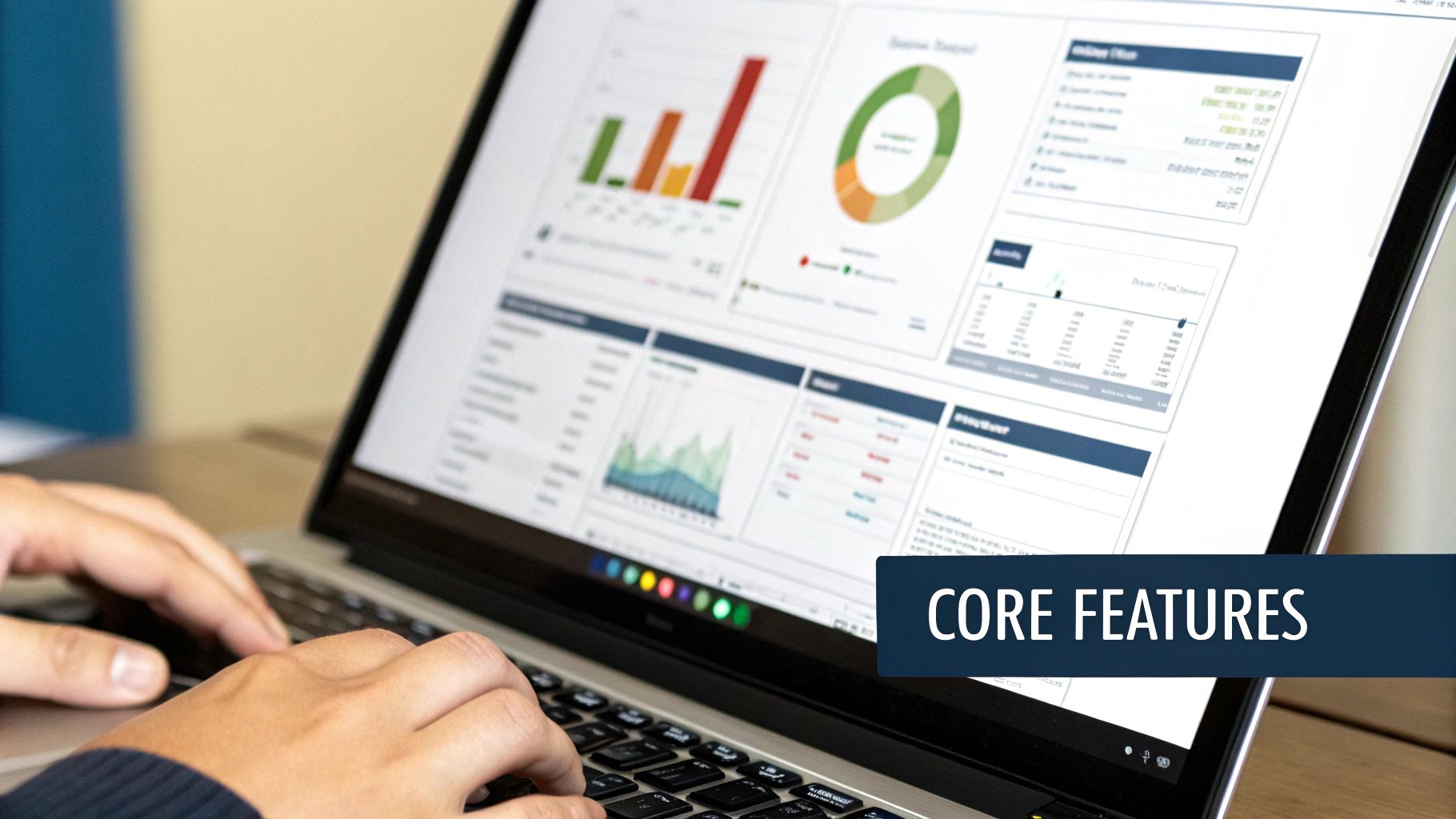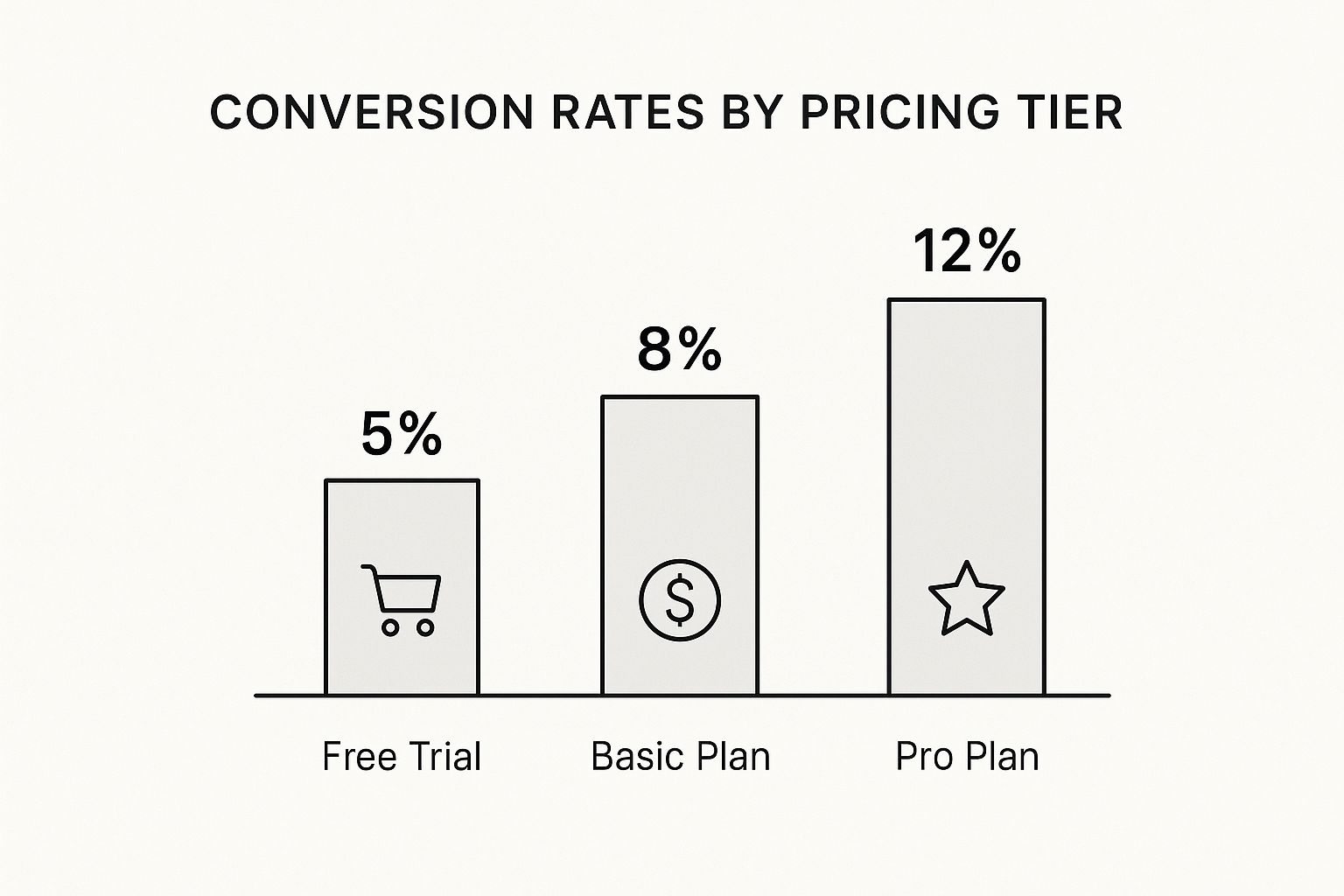Lead generation SaaS is simply software built to automate the messy, time-consuming process of finding and converting potential customers into actual, qualified leads. Think of it as an intelligent assistant for your business—one that helps you find, identify, and warm up prospects for your sales team before they ever pick up the phone.
What Is Lead Generation SaaS and Why It Matters
Imagine trying to fish in a vast ocean. You could spend all day casting a single line, hoping something bites. That’s the old way of prospecting—manual, slow, and often just plain frustrating.
Now, picture using a smart, automated net that knows exactly where the best fish are, catches them efficiently, and brings them right to your boat. That net is your lead generation SaaS.
It’s less of a dry, technical tool and more like a central nervous system for your entire growth strategy. It solves one of the most persistent pains in business: a leaky sales funnel clogged with unqualified contacts and bogged down by manual work.
So many businesses watch their sales teams spend a huge chunk of their day just hunting for names and emails, instead of doing what they do best—building relationships and closing deals. This is where a dedicated platform changes the game.
Moving Beyond Manual Prospecting
A good lead generation platform takes over all the repetitive, soul-crushing tasks that jam up your pipeline. It automates the heavy lifting of finding and qualifying potential customers, so your team gets a steady stream of high-quality, sales-ready leads. This simple shift frees them up to focus on strategic conversations instead of tedious data entry.
The benefits are pretty clear:
- Boosted Efficiency: It automates things like finding contact info, scoring leads based on their actions, and nurturing them with the right content at the right time.
- Higher Quality Leads: The software acts as a filter, weeding out the noise so your sales team only talks to prospects who have shown real interest.
- Tighter Sales and Marketing Alignment: Finally, it creates one unified system where marketing’s hard work directly feeds the sales pipeline with genuine opportunities.
A lead generation SaaS platform doesn't just hand you a list of names. It delivers context. It tells you who is interested, why they're interested, and how ready they are to talk, turning cold calls into warm conversations.
To see just how different these two approaches are, let's break it down.
Manual Prospecting vs SaaS-Powered Lead Generation
| Aspect | Manual Lead Generation | Lead Generation SaaS |
|---|---|---|
| Data Sourcing | Manually searching LinkedIn, websites, and directories. | Automated data scraping and aggregation from multiple sources. |
| Lead Quality | Inconsistent; often relies on guesswork and unverified data. | High; leads are scored and verified based on real-time behavior. |
| Efficiency | Extremely time-consuming, with hours spent on data entry. | Highly efficient, automating repetitive tasks in seconds. |
| Scalability | Difficult to scale; more leads require more people and hours. | Easily scalable; can handle thousands of prospects simultaneously. |
| Nurturing | Ad-hoc and manual follow-ups, easy for leads to fall through cracks. | Automated, personalized nurturing sequences based on user actions. |
| Insight & Analytics | Limited to non-existent; hard to track what's working. | Deep analytics on lead behavior, campaign performance, and ROI. |
The table makes it obvious: while manual effort has its place, it simply can't compete with the speed, accuracy, and intelligence of a dedicated SaaS platform when you're serious about growth.
The rising demand for these tools isn't just a trend; it's a fundamental shift in business strategy. The global market for this software is exploding, projected to hit $5.92 billion by 2025 with a compound annual growth rate of 10.0%. This growth is driven by one simple fact: businesses need data-driven, effective ways to generate sales. Learn more about lead generation software market trends.
When you adopt a lead generation SaaS, you aren't just buying another tool. You're investing in a smarter, more scalable, and ultimately more profitable way to grow your business.
What's Really Under the Hood? Core Features of Top Lead Generation Platforms

It’s one thing to talk about what lead generation software does, but it’s another to understand how the machinery actually works. These platforms aren't just fancy digital Rolodexes. They're sophisticated engines, with a set of specific, interconnected features built to find, qualify, and manage potential customers with incredible precision.
At their core, the best tools blend several key functions that seamlessly turn anonymous website visitors into qualified, sales-ready leads. Each feature is designed to solve a specific puzzle in the customer journey, from that first click to the final handoff to your sales team.
Let's pull back the curtain and look at the essential components you'll find in almost any top-tier platform.
Multi-Channel Lead Capture Tools
First things first: a lead generation tool has to actually capture leads. Today's best platforms do this across a ton of different channels, making sure you never miss a chance to connect with someone, no matter where they find you.
And we're talking about a lot more than a simple "Contact Us" form buried on your website. Modern platforms give you a whole toolkit of intelligent ways to engage visitors.
- Smart Forms and Pop-Ups: These aren't your average annoying pop-ups. They're smart. They can be triggered by specific user behaviors—like how long someone stays on a page, how far they scroll, or if they're about to leave—to show the perfect offer at just the right time.
- Interactive Chatbots: Think of these as your 24/7 digital concierge. AI-powered chatbots can answer basic questions, ask targeted qualifying questions, and even book a demo right on a sales rep's calendar, all while your team is sleeping.
- Landing Page Builders: Many platforms come with easy-to-use, drag-and-drop builders. This means your marketing team can spin up high-converting landing pages for specific ad campaigns without needing to wait for a developer.
These tools all work together, casting a wide net to ensure every touchpoint is optimized for capturing lead information.
Automated Lead Scoring and Qualification
Okay, so you've captured a lead. Now what? The big question is, "How interested are they really?" This is where automated lead scoring comes in to separate the tire-kickers from the serious buyers. Instead of making your sales team guess which leads are hot, the software does the heavy lifting.
Think of it like a credit score, but for your prospects. The system automatically assigns points based on who they are (demographics like job title or company size) and what they do (behaviors like visiting your pricing page or downloading a case study).
Lead scoring takes the guesswork out of prioritization. A lead who visited your pricing page three times and works for a company in your target industry gets flagged as a high-value, sales-ready contact. This lets your team jump on the opportunity immediately.
This data-first approach means your reps focus their energy where it counts: on the people most likely to become customers. It's a game-changer for efficiency and closing rates.
Contact Enrichment and Data Management
A name and an email are a starting point, but they're not enough for a real sales conversation. You need context. This is where contact enrichment becomes so valuable, automatically filling in the blanks on your lead profiles.
The software taps into public data and third-party databases to find and add critical information to each contact record, such as:
- Company size and industry
- The person's job title and seniority
- Links to social media profiles (especially LinkedIn)
- Technographics (what other software and tools they use)
Suddenly, a basic contact becomes a rich, detailed profile. Your sales team can walk into a call already knowing who they’re talking to, what their company does, and what challenges they might be facing. For a deeper look at this process, you can explore B2B data enrichment strategies to see just how powerful it is. This transforms your CRM from a simple contact list into a dynamic intelligence hub for your entire sales organization.
How SaaS Transforms Your Sales Funnel

Let's be honest, the traditional sales funnel can be a leaky, disconnected mess. Marketing pours everything into attracting an audience, but there's often a huge gap between those efforts and the leads that actually land on a salesperson's desk.
This is where a lead generation SaaS platform completely changes the game. Think of it as the smart plumbing that connects every stage of the funnel, transforming a clunky process into a smooth, intelligent journey for both your team and your prospects. Instead of just being a database for contacts, it actively manages and refines each step, bridging the all-too-common divide between marketing and sales.
At its core, this transformation is driven by smart automation and data. It’s about making sure no opportunity slips through the cracks and every bit of effort pays off, fundamentally reshaping how you guide someone from a curious visitor to a paying customer.
Top of the Funnel: Awareness and Capture
At the top of the funnel (ToFu), your goal is simple: get noticed and capture interest. This is where your blogs, social media, and SEO efforts do the heavy lifting. A lead generation platform comes in and gives that content a job to do—turning passive visitors into real, actionable contacts.
It does this with capture tools that are far more sophisticated than a simple "Contact Us" form:
- Behavior-Triggered Pop-ups: Imagine a visitor spends five minutes reading a detailed guide on your site. Just as they finish, a pop-up offers them a related ebook. You've captured their info right at their peak moment of interest.
- Interactive Quizzes or Calculators: A fintech company could offer an ROI calculator that shows potential savings. To get the results, a prospect enters their email, giving you a valuable lead in exchange for personalized insight.
- Chatbots for Immediate Engagement: A chatbot can greet website visitors, answer their basic questions, and point them to the right resources, making sure no one leaves frustrated or confused.
These tools don't just sit and wait. They proactively engage visitors, which can dramatically boost the number of new leads flowing into your funnel and ensure your content investment actually generates a return.
Middle of the Funnel: Nurturing and Qualification
Once you have a contact, they enter the middle of the funnel (MoFu). This is where most manual sales processes completely fall apart, but it’s where a lead generation SaaS truly shines. The platform takes over the delicate work of nurturing interest and qualifying leads automatically, long before a salesperson ever gets involved.
Instead of letting new contacts go cold, the system triggers automated email sequences. Someone who downloaded your ebook on social media marketing might get a case study on the same topic a few days later. It feels personal, but it's all automated.
This automated nurturing keeps your brand top-of-mind and gently guides prospects deeper into the funnel. It ensures that by the time a lead is passed to sales, they are educated, engaged, and genuinely interested in finding a solution.
All the while, the platform’s lead scoring system is running in the background. It tracks every little action—opening an email, clicking a link, visiting your pricing page—and assigns points. This paints a crystal-clear picture of who's just browsing and who's getting serious. For a deeper look at how this works, our guide on building a sales automation process breaks it all down.
Bottom of the Funnel: Conversion and Handoff
When a lead's score hits a certain number, they’ve reached the bottom of the funnel (BoFu). They're now considered a Marketing Qualified Lead (MQL), and it's time for the big moment: the handoff to sales. A lead gen platform makes this transition completely seamless.
Your sales reps get an instant alert with a full dossier on the lead: their activity history, company details, and engagement score. This context is pure gold. It turns what would have been a cold call into a warm, highly relevant conversation because the rep knows exactly what the lead cares about.
This data-driven handoff finally gets sales and marketing on the same page. Sales starts trusting the quality of the leads they receive, and marketing can clearly see which campaigns are actually making money. It's no surprise the global lead generation market is expected to hit $6.38 billion in 2025; businesses are realizing the massive value of this tech-driven alignment.
Ultimately, a SaaS platform turns your funnel from a leaky bucket into a high-pressure hose, delivering a powerful and consistent stream of opportunities.
Finding the Right Type of Lead Generation Tool
Not all lead generation tools are built the same, and picking the right one can feel like trying to find a needle in a haystack. The market is packed with platforms serving wildly different needs, from sprawling, all-encompassing suites to hyper-focused tools that do one thing perfectly. Getting a handle on these main categories is the first step to finding a solution that actually fits your business, budget, and goals.
Think of it like a mechanic's toolbox. You wouldn't use a wrench to hammer a nail. You need the right tool for the job. In the same way, the best lead generation SaaS for you depends entirely on what you're trying to accomplish—whether that's finding brand new contacts, engaging them with targeted outreach, or converting the visitors already on your website.
Let's walk through the main types of platforms out there to give you a clear map of the territory.
All-in-One Marketing Automation Suites
These are the Swiss Army knives of lead generation. Platforms like HubSpot or Marketo bundle a huge range of features into a single, integrated system. We're talking email marketing, CRM, landing page builders, social media management—the whole nine yards. They're designed to manage the entire customer journey from start to finish.
The real power here is having a single source of truth for all your marketing and sales data. This is a game-changer for larger teams trying to keep complex campaigns in sync and measure ROI across different channels. The trade-off? That comprehensive functionality usually comes with a hefty price tag and a significant learning curve, which can be overkill for a small business just getting its feet wet.
Specialized Lead Capture and Conversion Tools
While the all-in-one platforms try to do everything, these specialized tools are masters of one thing: turning your website visitors into leads. Think of tools like OptinMonster or Leadpages. Their entire world revolves around creating high-impact forms, pop-ups, and landing pages engineered for maximum engagement.
These platforms are a perfect fit if you already have decent website traffic but are struggling to convert those eyeballs into actual contacts. They give you incredibly deep customization options and A/B testing features, letting you fine-tune every last detail of your capture strategy. Plus, they’re often far more affordable and easier to set up than the big suites, making them a fantastic starting point.
The image below shows just how much the features included in different SaaS pricing tiers can influence your lead capture and conversion rates.

As you can see, investing in a more advanced plan often unlocks the very features that will give your conversion numbers a serious boost.
B2B Data and Prospecting Platforms
This category is all about fueling your outbound sales engine. Platforms like ZoomInfo, Lusha, or our very own Nordic Lead Database are focused on one thing: providing accurate, in-depth contact and company data. Instead of waiting for leads to come to you, these tools empower you to proactively find and connect with your ideal customers.
These platforms are indispensable for any company with a clearly defined ideal customer profile (ICP) that relies on direct sales or account-based marketing (ABM). The B2B lead generation software market is booming for a reason—it was valued at around $3.2 billion in 2023 and is expected to hit $9.8 billion by 2032. This incredible growth, which you can read more about in this B2B software market report, shows just how much businesses now rely on data to make their sales efforts more efficient.
By giving you direct dials, verified emails, and company org charts, these platforms take the guesswork out of prospecting. They let your sales reps skip the busywork and get straight to having meaningful conversations.
Conversational Marketing Platforms
Last but not least, we have conversational marketing tools. Platforms like Drift or Intercom use chatbots and live chat to engage your website visitors the moment they arrive. The idea is to replace static, boring forms with dynamic, real-time conversations that can answer questions, qualify leads, and even book meetings on the spot.
These tools are fantastic for capturing high-intent leads who are actively looking for information on your site. They create a more personal and immediate experience, which can dramatically shorten the sales cycle by connecting qualified buyers with your sales team in seconds. This makes them a powerful tool for any business wanting to provide instant, helpful engagement.
Comparison of Lead Generation SaaS Types
To help you see how these categories stack up against one another, we've put together a quick comparison table. This should give you a clearer picture of which tool type might be the best starting point for your specific needs.
| Tool Type | Primary Use Case | Example Features | Best For |
|---|---|---|---|
| All-in-One Suite | Managing the entire customer lifecycle from a single platform. | CRM, Email Marketing, Landing Pages, Social Media | Larger teams needing a unified view of all marketing and sales activities. |
| Lead Capture & Conversion | Turning existing website traffic into leads and subscribers. | Pop-ups, Forms, Landing Page Builders, A/B Testing | Businesses with good traffic but low conversion rates. |
| B2B Data & Prospecting | Proactively finding and contacting ideal B2B customers. | Contact Databases, Verified Emails, Direct Dials, Firmographics | Sales-led organizations with a well-defined ideal customer profile (ICP). |
| Conversational Marketing | Engaging website visitors in real-time to qualify and convert them. | Live Chat, Chatbots, Automated Meeting Booking | Companies wanting to provide instant engagement and shorten their sales cycle. |
Ultimately, the "best" tool is the one that solves your most pressing problem right now. You don't have to boil the ocean; start with the tool that addresses your biggest bottleneck and build your stack from there.
How to Choose the Right Lead Generation SaaS

With a seemingly endless sea of options, picking the right lead generation SaaS can feel like a monumental task. But this is more than just a software purchase; it's a strategic decision that will directly shape your team's effectiveness and your company's bottom line.
Think of it like choosing a vehicle for a cross-country road trip. A flashy sports car looks great, but if you're hauling gear and facing unpredictable terrain, a versatile SUV is the smarter play. The best platform is the one that truly fits your specific journey, your team (the passengers), and where you're headed (your business goals).
Let's walk through a practical framework to help you make a smart investment, ensuring you land a tool that actually works for you, not just one that looks good in a demo.
Define Your Core Needs and Goals
Before you even glance at a vendor’s website, you have to look inward. What specific problem are you really trying to solve? A vague goal like "get more leads" is a recipe for choosing the wrong tool. You need to get granular.
Start by asking some tough questions:
- Are we struggling to convert the visitors already coming to our website?
- Do we need a better, more efficient way to find new B2B contacts for our outbound sales team?
- Is our biggest bottleneck nurturing existing leads until they’re actually ready to talk to sales?
The answers will point you to your primary use case. This clarity is everything. It acts as a filter, immediately ruling out platforms that don’t solve your most urgent problems and helping you build a simple 'must-have' versus 'nice-to-have' feature list.
Evaluate Integration Capabilities
Your new lead generation SaaS won't be operating on an island. It has to play nicely with the tools your team already relies on, especially your CRM. A clunky, disjointed integration will create more headaches and manual data entry than it solves.
Look for platforms with native, out-of-the-box integrations for your core stack, whether that's Salesforce, HubSpot, or your email marketing software. If a direct connection isn't available, check for a robust API or support through middleware like Zapier. A smooth, automated flow of data is non-negotiable for maintaining a single, reliable view of your customer.
Assess Scalability and Future Growth
The platform that’s perfect for your startup today might become a straitjacket a year from now. As your business scales, your lead volume will multiply, and your strategies will become more sophisticated. You need a platform that can grow right alongside you.
When thinking about scalability, consider these points:
- Pricing Tiers: Do the pricing plans make sense for a growing company? Or will a small bump in contacts or users launch you into an absurdly expensive tier?
- Feature Unlocks: Are there more advanced features available in higher plans that you can see yourself needing down the road, like deeper analytics or complex automation?
- Performance: Can the system actually handle a 10x increase in lead volume without grinding to a halt?
Choosing a scalable solution from the start helps you avoid the painful and expensive process of migrating systems right when your business is gaining momentum.
The right platform should feel like an investment in your future, not just a patch for today's problems. It should offer a clear growth path, so you aren’t forced to rip and replace your tech every couple of years.
Prioritize Ease of Use and Team Adoption
Here’s the hard truth: even the most powerful software on the market is worthless if your team hates using it. User adoption isn't a "nice-to-have"; it's the single biggest factor in whether you'll see a return on your investment.
This is where free trials and demos become your best friend. Don't just sit through a polished sales pitch. Get your team's hands on the product. Can they actually build a landing page, set up a simple lead-scoring rule, or find a prospect's email without needing a manual?
Their feedback is gold. A platform they find intuitive is one they will actually use, day in and day out. For instance, being able to define your ideal buyer is a core function. You can learn more by exploring different customer segmentation strategies and then see how easily a potential tool lets you put those ideas into practice. A user-friendly platform means a faster rollout and a much quicker path to real results.
Best Practices for Maximizing Your ROI
Buying a lead generation platform is a lot like getting a gym membership. Just having it doesn't get you in shape; you have to show up, put in the work, and follow a smart plan. Getting a real return on your software investment requires a disciplined strategy that goes way beyond the initial setup.
Without a roadmap, even the most powerful tool is just an expensive line item. The trick is to turn its features into a repeatable system for growth. This isn't a one-and-done project. Think of it as a core business function that you constantly measure, refine, and improve over time.
Set Clear and Measurable Goals
First things first: you need to define what winning actually looks like. A fuzzy goal like "get more leads" is useless because you can't measure it. Instead, you need specific targets tied directly to real business outcomes. This is how you'll prove the software was worth the money.
Get concrete and put a deadline on it. For instance:
- Increase Marketing Qualified Leads (MQLs) by 25% this quarter.
- Boost our lead-to-customer conversion rate by 15% in the next six months.
- Cut the average sales cycle by 10 days for leads that come through the platform.
When you have real numbers like these, your team knows exactly what they're aiming for, and it’s easy to show the CFO that the platform is paying for itself.
Constantly Test and Optimize Everything
Your first campaign or lead form is really just a starting point—your best educated guess. The real magic happens when you start testing everything and let the data guide your next move. The best place to start is with your lead capture points, where even tiny tweaks can have a surprisingly big impact.
Don’t assume you know what your audience wants. A/B testing isn't just a nice-to-have; it's the engine that drives improvement. You should constantly be testing different headlines, button text, form lengths, and pop-up triggers to see what actually gets people to convert.
This data-driven approach takes the guesswork out of the equation. When you discover that changing a button color lifts form submissions by 5%, you’re no longer just tweaking a design. You're making a calculated business decision that directly grows your pipeline.
Align Your Sales and Marketing Teams
Finally, you could have the best lead generation software on the planet, but it will fall flat if your sales and marketing teams aren't on the same page. The handoff between these two departments has to be seamless. It's not a luxury—it's the absolute foundation of a healthy revenue engine.
Both teams need to agree on what a "good lead" actually is. This alignment makes sure marketing is busy attracting prospects that sales can realistically close, which stops the blame game and wasted effort before they start. Set up regular meetings to review lead quality, share feedback, and tweak your lead scoring. When sales and marketing operate as a single, unified team, your platform becomes the true engine for predictable, scalable growth.
Frequently Asked Questions
It's smart to ask questions when you're looking into lead generation software. After all, it's a big investment in your company's growth, and you need to be sure before you jump in. Here are a few of the most common things people ask when they're considering these kinds of tools.
How Long Until I See Results?
This is the big one, isn't it? The honest answer is: it depends, but you can see wins almost immediately.
For example, you could add a clever pop-up to your most popular blog post or turn on a chatbot for your pricing page. Things like that can start bringing in new leads within a day, sometimes even just a few hours. These quick victories are fantastic for getting the ball rolling.
But the real, lasting value of a lead generation SaaS isn't about that first quick hit. It comes from the work you put in over time. The biggest returns show up after a few months of collecting data, A/B testing your contact forms, tweaking your lead scoring, and building out smart email follow-ups. Think of it less like flipping a switch and more like tuning an engine—the longer you work on it, the better it performs.
Can a Small Business Benefit from These Tools?
Definitely. In fact, small businesses often get the biggest boost from them. Many of the best platforms out there have pricing plans that are specifically designed to be affordable and scalable for smaller teams. It's not just another expense; the right tool is like hiring a new team member that works 24/7.
The efficiency gains for a small team are huge. A single piece of software can handle capturing new leads, figuring out which ones are sales-ready, and starting the follow-up process. This frees up your people to do what they do best: talk to potential customers and close deals. It really does level the playing field, giving smaller companies access to the kind of powerful tools that used to be only for the big players.
For a small business, a lead generation platform isn’t just about getting more leads; it’s about making the absolute most of every single one. It ensures no opportunity falls through the cracks due to a lack of time or resources.
How Does This Software Integrate with My CRM?
Any lead generation tool worth its salt has to play nicely with your CRM. It's not an optional feature; it's essential.
Most of the top platforms have built-in, one-click integrations with the big names like Salesforce, HubSpot, and Zoho. This means your lead data flows back and forth between the two systems automatically, no manual data entry required.
What if you use a more specialized or custom-built CRM? Good platforms will have a solid API (Application Programming Interface). This lets your tech team build a custom bridge between the two, so everything syncs up perfectly. That two-way data flow is crucial—it makes sure your sales team always has the latest info on a lead, right inside the system they use all day.
Ready to supercharge your sales pipeline with high-quality, targeted data? Nordic Lead Database offers the most extensive database of decision-makers in the Nordics. Find your next customer today!
